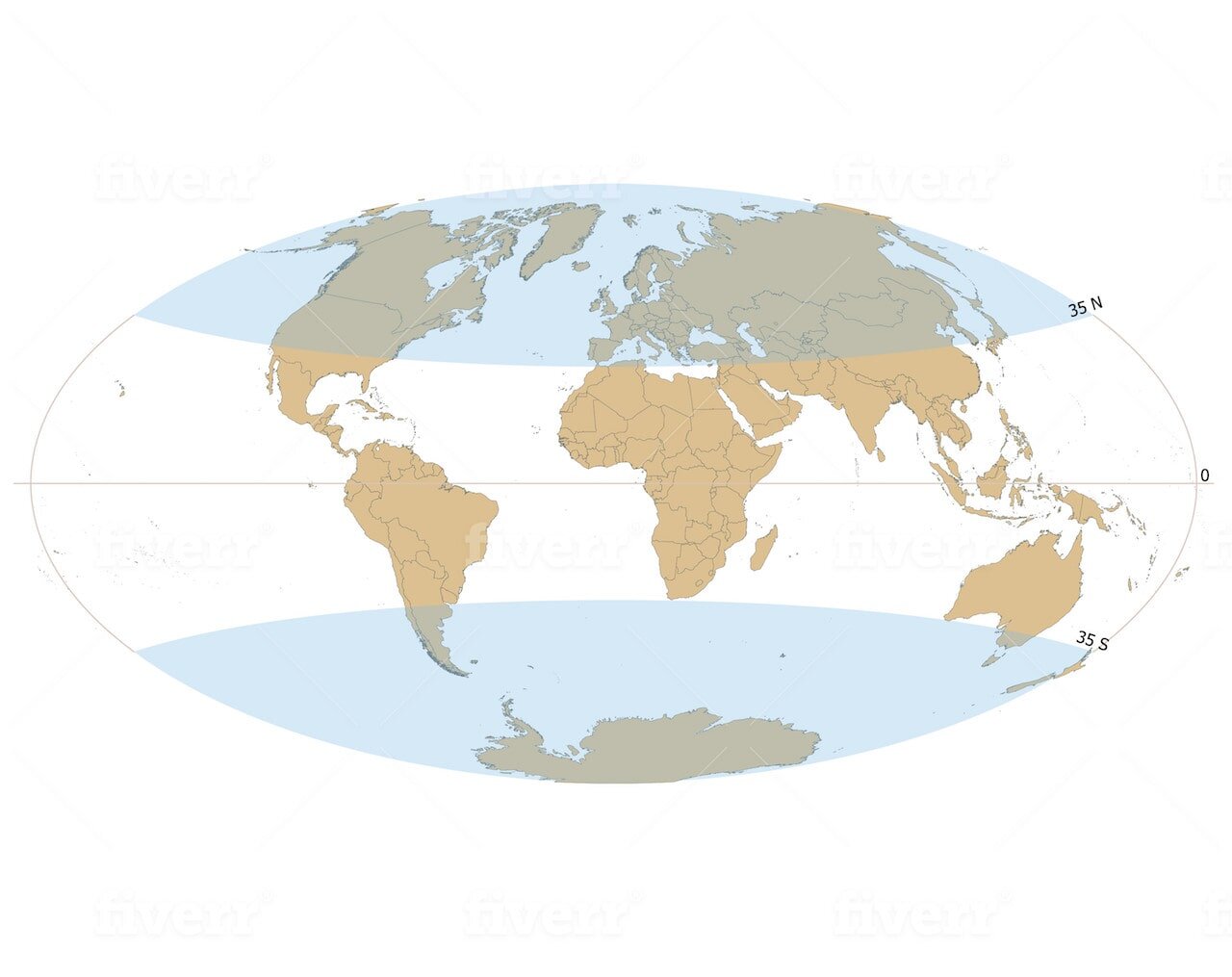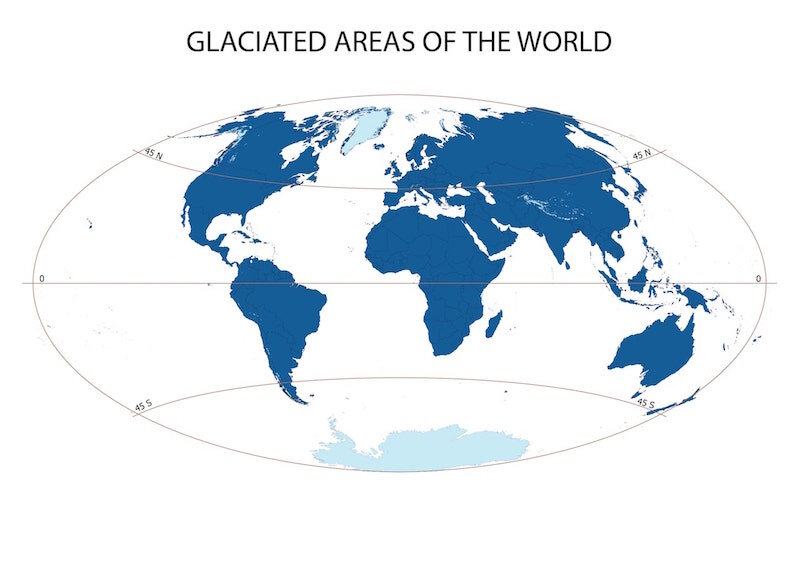Does it snow in the Southern Hemisphere?
Yes. In the Southern Hemisphere, seasonal snowfall occurs in:
The high elevations in eastern Australia
The South Island of New Zealand
Southern parts of South America (SNOWIEST REGION in the Southern Hemisphere)
Patagonia and Tierra del Fuego region in both Chile and Argentina is the snowiest region in the Southern Hemisphere with regular seasonal snowfall south of 45° latitude
The high elevations of the Andes Mountains in Argentina, Bolivia, Chile, and Peru
Antarctica
“However, South America is the only continent in the Southern Hemisphere (other than Antarctica) where an extensive, winter snow cover may occur”
snowfall & latitude 35° N and 35° S
Seasonal snowfall occurs at sea level poleward of latitude 35° North and 35° South. This means that seasonal snowfall is essentially confined to 4 countries (Australia, New Zealand, Argentina, & Chile) plus Antarctica.
On the west coast of continents, the snow generally falls only at higher latitudes
However, snow does fall close to the equator. This snowfall is exclusively found in the tallest mountain regions (above 16,000 feet/4900 meters)
Columbia: The Sierra Nevada de Santa Marta receives snow (18,701 feet/5,700 meters)
Ecuador: July - August are the snowiest months above 5000 meters or 16,404 feet
The Sierra Nevada de Santa Marta, Columbia is located less than 800 miles from the equator. However, these mountains are located in the northern hemisphere.
What is the snowiest month in the Southern Hemisphere?
May to September are the snowy months with July being the snowiest month in the Southern Hemisphere.
Snowman in Bariloche, Argentina, South America
northern vs southern hemisphere & snow
The landmasses of the Northern Hemisphere are located much closer to the poles compared to the landmasses of the Southern Hemisphere (excluding Antarctica).
Because of this and the subsequent interactions, the majority of the world’s snowfall occurs in the Northern Hemisphere:
High-pressure systems or anticyclones are less common in the Southern Hemisphere
The Southern Hemisphere has less land in the mid-latitudes. This results in the southern westerlies (wind) being the strongest in the world. An effect of this: “large nearly stationary ‘high’ systems such as the ‘Siberian High’ become established less frequently. These large ‘highs’ are important in refrigerating surface air and influencing the strength and tracks of storm systems.” (Foster et al. in Remote Sensing of Environment)
Seasonal snow falls at sea level poleward of latitude 35° North and 35° South with regular seasonal snow fall south of latitude 45° S
Noaa & snow records: Southern hemisphere
The National Oceanic and Atmospheric Administration (NOAA) doesn’t measure snow cover in the Southern Hemisphere, because of 3 primary reasons:
Snow can only be measured over land. Most of the snowy regions in the Southern Hemisphere are covered by ocean.
The mid and high-latitudes that do receive snowfall are small, excluding Antarctica.
The high elevations of South America and Antarctica are covered by glaciers, which makes it “nearly impossible to distinguish snow cover from glacial ice using current satellite technology.”
Because of these reasons, finding snowfall records outside of local reports is nearly impossible. Determining how much snowfall actually occurs in cities across the Southern Hemisphere is difficult and unreliable, since no official snowfall records are available.
Accumulated annual snowfall
Figure: Accumulated annual snowfall divided by annual runoff over the global land regions. Source: (Barnett et al.)
“The physics governing the Andean glaciers are more complicated than simple temperature forcing”
The map above is from a 2005 artice in Nature, entitled the Potential Impacts of a Warming Climate on Water Availability in Snow-Dominated Regions.
Outside of the high mountainous areas of South America and New Zealand, to a lesser extent, the Southern Hemisphere has minimal snow accumulation. This article highlighted several important points:
In general, the snowmelt-dominated regions occupy parts of the globe that are at latitudes greater than 45 degrees (north and south)
Mountainous regions (except those nearest the Equator) are generally snowmelt-dominated
The data used for this article was from 1980 to 1999
As you can see from this map, only the very southerly section of South America (Patagonia) and a tiny portion of New Zealand receive annual snowfall (excluding the highest mountain regions).
El Chaltén, Argentina, Southern Hemisphere
Ski resorts & snowfall - South America & New Zealand
When most people think of skiing in the Southern Hemisphere, Queenstown, New Zealand is the first place that comes to the mind of many skiers and snowboarders. However, South America’s Patagonia has some of the best skiing in the world.
Snowfall data for the South Island of New Zealand
Corralco Ski Resort - Chile (Araucanía Region)
Average snowfall: ~ 280 inches (711 cm)
2015: 695 inches (1,765 cm)
Catedral Alta Patagonia Ski Resort (Bariloche, Argentina)
Average snowfall: ~ 200 inches (508 cm)
2015: 352 inches (894 cm)
Treble Cone Ski Area (Treble Cone, New Zealand)
Average snowfall: ~75 inches (175 cm)
Highest snowfall annual average of any ski area/resort in New Zealand
2015: 101 inches (255 cm)
Jesse is Director of Pedal Chile and lives in Chile’s Patagonia (most of the year). Jesse has a Master of Science in Health and Human Performance and a Bachelor of Science in Kinesiology. Hobbies: Reading, researching, writing, snowboarding, and climatology.
Additional articles from Jesse at Pedal Chile
Sources:
Barnett, T. P., et al. “Potential Impacts of a Warming Climate on Water Availability in Snow-Dominated Regions.” Nature, vol. 438, no. 7066, Nov. 2005, pp. 303–309.
Clark, Martyn, et al. “Simulations of Seasonal Snow for the South Island, New Zealand.” Journal of Hydrology (New Zealand), vol. 48, no. 2, 2009, pp. 41–58. (image source for New Zealand data)
“Did You Know? | Monitoring References | National Centers for Environmental Information (NCEI).” Www.Ncdc.Noaa.Gov
Foster, J.L., et al. “Seasonal Snow Extent and Snow Mass in South America Using SMMR and SSM/I Passive Microwave Data (1979–2006).” Remote Sensing of Environment, vol. 113, no. 2, Feb. 2009, pp. 291–305.
Kenneth Frederic Dewey, and Richard Heim. Satellite Observations of Variations in Southern Hemisphere Snow Cover. Washington, D.C, National Oceanic And Atmospheric Administration, 1983.









